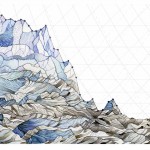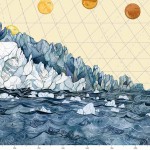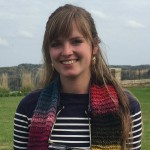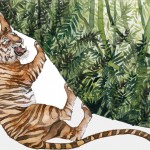By Lakshmi Chandrasekaran –
Glaciers and forests show jagged retreats in Jill Pelto’s paintings while the sky above heats up. Pelto, a graduate student studying climate science at the University of Maine, uses her art to convey the impacts of climate change on world environments.
She overlays climate change research data with striking colors and vivid imagery to depict our living world amid rising temperatures. Her watercolor paintings convey multiple layers of information, all the while visualizing the problems of climate change. Jill calls her works “glaciogenic art.”
Jill combined both her passions for art and climate science during her undergraduate studies at the University of Maine where she graduated last year with a double major in studio art and earth science. Through the dual media of painting and data she strives to convey the impact of our unsustainable practices on climate and environment. A tiger clings to a disrupted, shrinking ecosystem in one painting. Using data that shows the decline in forest area from 1970-2010, Jill’s painting on habitat degradation depicts why tigers are an endangered species today due to human impact on their environments worldwide. Another painting shows the annual decrease in the size of glaciers worldwide, global sea level rise and global temperature increases, all incorporating climate change data.
Her paintings have been featured on PBS, Climatecentral.org, Smithsonian.com, among other venues. At the recent Comer Abrupt Climate Change Conference in Wisconsin, she presented her research project that explores the vulnerability of seals in the Southern Ocean to climate change, rather than her artworks. She talked with Medill Reports about her inspiration for both.
Q. What inspired you to combine your passions for art and science?
A. I have always been inspired by outdoors and nature and always had a passion for art. So as an undergraduate at University of Maine, I originally started as an art major and I knew that I wanted to investigate some sort of sciences, so I ended up in their science program. And, throughout my career, I had wondered how could I combine these two? I worked on many ideas for a long time and used a lot of my art class assignments to try and do something scientifically themed.
Q. But converting scientific data into art? What drove you to make that interpretation?
A. I started to convert graphical data from climate change research, into art in response to one dramatic year working in Washington State on one of the glaciers.
Q. Dramatic? How?
A. In 2015, there was a major drought in the West and Washington was hit very hard by that. Just seeing those impacts more personally than I had before, such as being caught in forest fire smoke, seeing the reservoirs getting dry, seeing glaciers so diminished and having virtually no snow on them. That inspired me to make a series of paintings using scientific data collected from 1980 to 2014 of the average mass balance for a group of North Cascade, Washington glaciers. Mass balance is the annual budget for the glaciers: total snow accumulation minus total snow ablation.
Q. I understand that part of your interest in climate change has been kindled in response to going on field trips with your dad. Can you tell us a little bit about your expeditions together?
A. My dad has been running the North Cascade Glacial climate project in Washington for the past 33 years. He began it when he was working on his Ph.D. thesis in University of Maine and specifically measures how the glaciers change year to year. I started going out with my dad to these field trips from high school. I have been going for the last eight years now. It’s an intensive field season backpacking and camping for about three weeks, every summer. It’s wonderful to be able to work with my dad. My brother is also in glaciology and I have worked with him in British Columbia.
Q. Wow, an entire family committed to climate change research! Are there specific scientific themes you have used in your art, which you like to explore more often?
A. Just looking at data from my dad’s project – fairly dramatic declines in glaciers – struck me as the profile of glaciers. I started brainstorming after that and did a three-part series showing glacial decline, salmon population data since their population is dwindling and rising temperatures [that contribute to] forest fires.
Q. Who do you want to be your target audience?
A. I’m still defining it. So far a lot of people have already responded to it and those folks seem to be the ones who are environmentally conscious people. I want my audience to be more general public and reach those who may not be moved by an article or a scientific paper, or willing to stop and look at a graph.
Q. Where did you get this data?
A. Some of the data is based on the field work that I have helped with and some of them I found online, while researching different sources such as NOAA.
Q. Collecting scientific data requires one particular mindset and art seemingly another. Am I wrong?
A. Art and science are really important and require observational skills. One of my favorite things doing field work is bringing my artistic mind to it. While in field, I do a number of sketches using pens, watercolors that I bring with me. Every place I went to I have done a lot of preliminary sketches, capturing what is in front of me– such as landscapes. So that just has been really incredible and is a way to see things via a different lens.
Q. Have you done art shows or exhibits?
A. So far mostly, I have done just group shows in Chicago, Philly, Maine. One was this summer, at Mount Desert Island Biological Laboratory, which is near Acadia National Park in Maine, where do they a show called ‘Art meets science’ every year.
Q. What kind of feedback have you gotten so far?
A. The feedback has really been positive and I heard from a lot of people from different backgrounds all over the world, which is great. Additionally, I have been selling a lot of my work on Etsy, an online marketplace.
Q. So, what do you want to do in the future?
A. I have talked to quite a few scientists about doing collaborations with them and that’s something I will be able to focus on more on after I finish my Master’s. I have so many ideas for future work that I will explore – marine debris, how marine debris affects marine creatures, shifting ecosystems with climate change, global strides with clean energy, sustainable practices with farming, food waste.
Q. Ok, so a lot more research will be going into your art. Going back to basics, why did you name your endeavor ‘glaciogenic’ art?
A. Glaciogenic refers to processes that help form glaciers. So as I love glaciers and have spent so much time working on them, I named my art practice as that to imply art that helps form glaciers, by informing people about glaciers and promoting a clean environment through knowledge.




